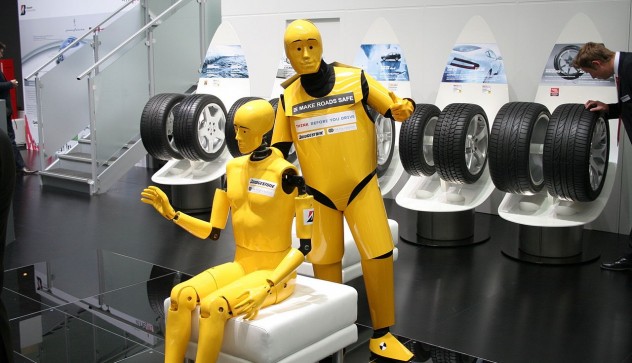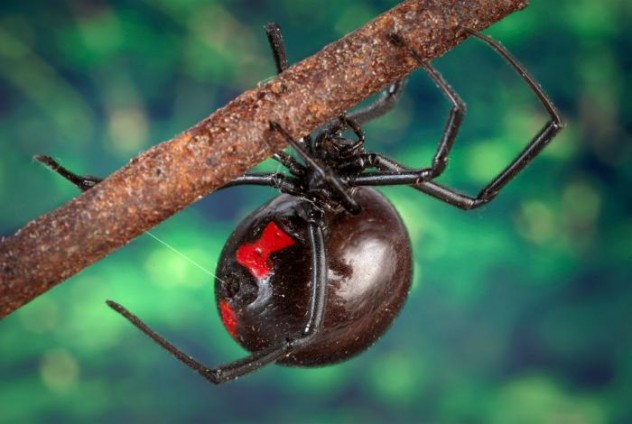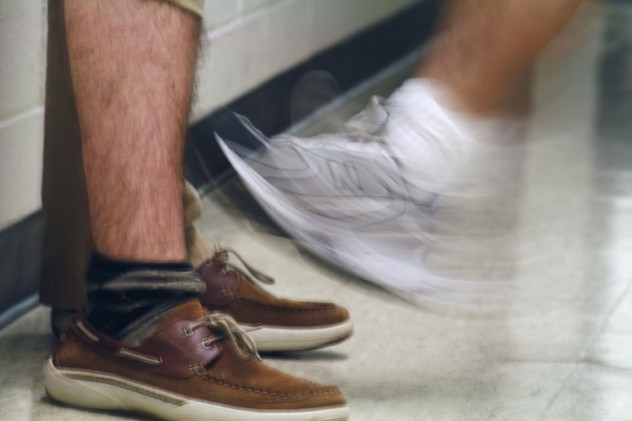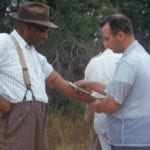 Politics
Politics  Politics
Politics  Weird Stuff
Weird Stuff 10 Eggs-traordinarily Odd Eggs
 History
History 10 Desperate Last Stands That Ended in Victory
 Animals
Animals Ten Times It Rained Animals (Yes, Animals)
 Mysteries
Mysteries 10 Devastating Missing Child Cases That Remain Unsolved
 Creepy
Creepy 10 Scary Tales from the Middle Ages That’ll Keep You up at Night
 Humans
Humans 10 One-of-a-kind People the World Said Goodbye to in July 2024
 Movies and TV
Movies and TV 10 Holiday Movies Released at Odd Times of the Year
 Politics
Politics 10 Countries Where Religion and Politics Are Inseparable
 Weird Stuff
Weird Stuff 10 Freaky Times When Famous Body Parts Were Stolen
 Politics
Politics The 10 Most Bizarre Presidential Elections in Human History
 Weird Stuff
Weird Stuff 10 Eggs-traordinarily Odd Eggs
 History
History 10 Desperate Last Stands That Ended in Victory
Who's Behind Listverse?

Jamie Frater
Head Editor
Jamie founded Listverse due to an insatiable desire to share fascinating, obscure, and bizarre facts. He has been a guest speaker on numerous national radio and television stations and is a five time published author.
More About Us Animals
Animals Ten Times It Rained Animals (Yes, Animals)
 Mysteries
Mysteries 10 Devastating Missing Child Cases That Remain Unsolved
 Creepy
Creepy 10 Scary Tales from the Middle Ages That’ll Keep You up at Night
 Humans
Humans 10 One-of-a-kind People the World Said Goodbye to in July 2024
 Movies and TV
Movies and TV 10 Holiday Movies Released at Odd Times of the Year
 Politics
Politics 10 Countries Where Religion and Politics Are Inseparable
 Weird Stuff
Weird Stuff 10 Freaky Times When Famous Body Parts Were Stolen
10 More Crazy Self-Experiments In The Name Of Science
In the world of science, using other people and animals as test subjects is very useful, but sometimes if you want to get something done right, you have to do it yourself. The following list contains stories of self-experimentation, all done in the name of science. Some experiments ended in great breakthroughs being made, while others ended in disaster.
10 The Human Crash-Test Dummy

John Paul Stapp was an experienced Air Force officer and flight surgeon who was very interested in the effects of rapid acceleration and deceleration, among other things, on the human body. While the thought of what happens to the human body when it is quickly accelerated to its limits seems disheartening to many, Stapp took it upon himself to showcase these effects in an attempt to improve aircraft safeguards and equipment. At the time, it was believed that the human body could only withstand up to 18 G-forces before death resulted. Stapp, on the other hand, proved this limit to be much larger as he subjected himself to greater peak G-forces than any human had experienced.
Using a massive rocket sled decelerator known as the “Gee Wiz,” Stapp was able to prove that humans could withstand 46 times the force of gravity using the correct harness. The G-forces were ramped up at a rate of 500 Gs per second (he later did another trial up to 38 Gs at a rate of 1,300 Gs per second). Of course, just because he was alive didn’t mean his body was happy about it: he suffered broken limbs, ribs, a detached retina, burst blood vessels, and an array of other injuries. In his experiments on the effects of altitude sickness and decompression sickness, this human crash-test dummy decided to strip down his B-17 bomber and fly at 13,700 meters (45,000 ft) altitude for 65 hours with an open cockpit in a depressurized cabin. In doing so, Stapp subjected himself to 570 mph winds.
He discovered that if pilots inhaled pure oxygen for 30 minutes before take off, they could handle insanely high altitudes much better. He was able to develop a sideways-facing harness, lap belt, and shoulder strap on fighter seats for greater safety. His discoveries also led to the requirement of seatbelts in cars.
9Self-Surgery (Appendectomy)

Most people put their total faith in their surgeons when they need an operation, but Evan O’Neill Kane wasn’t going to have any of that and felt no one was more fit for the job than himself. In an extremely bizarre case of self-experimentation, Kane wanted to experience the process of surgery from the patient’s point of view in order to better understand their perspective. Kane hoped to use local anesthetics on patients who wouldn’t respond to general ones and, in the ultimate act of taking one for the team, took it upon himself to test the validity of his hypothesis.
While Kane did have a history of performing self-operations like amputating one of his fingers, this surgery was the first of its kind. Ether was a popular general anesthetic used in the day, but Kane felt it was too dangerous and wished to see the effects of Novocain as a local anesthetic. After he dosed himself up with Novocain, Kane got to work on removing his appendix with the use of mirrors. The operation at the time required a much larger incision than today, making it significantly more dangerous. Despite the risks, the 60-year-old had completed the surgery over 4,000 times on other patients. This operation was no different: he was up and moving the next day. The operation lasted just 30 minutes and the only scary moment occurred when his intestine popped out because of how he was sitting.
Ten years later, at the age of 70, Kane was also able to repair his own hernia. This operation was especially dangerous because of how close the incisions were to his femoral artery. Unfortunately, other complications got to him, and a bad case of pneumonia killed him within a few months.
8 The Human Billy Goat

Rather than just exercise or dieting, Fredrick Hoelzel set out on an extreme weight loss diet of eating foods without calories. Now before you get all excited about this new weight loss technique, these non-caloric objects should hardly be classified as “foods.” Hoelzel began eating things like corncobs, cork, feathers, sawdust, asbestos, rayon, and banana stems in an attempt to lose weight during those pudgy and embarrassing teenage years. His daily diet almost always consisted of his favorite “food,” surgical cotton. As a researcher at the University of Chicago, Hoelzel put his diet to good use by eating objects to see how quickly they passed through him in the name of science. Small steel and silver objects took a mere eight hours, while gold pellets took a whopping 22 days. Glass beads were able to slip through in only 40 hours. The fastest-digested object was a piece of twine that zipped through in only 1.5 hours. His weight loss method was incredibly effective, leaving him pale and malnourished. I wouldn’t suggest trying this at home.
7 Testing the Testes

While to most men, having multiple weights stacked on to your testicles seems a little too extreme for any scientific experiment, Hebert Woollard and Edward Carmichael jumped at the chance. While its not confirmed which of the scientists used their testicles (which is odd because if I had been a part of the experiment, I’d definitely claim the pain I went through for science), they were studying the phenomena of referred pain. Referred pain is the sensation of pain in another part of the body when an internal organ is harmed. While there were a myriad of organs to choose from, Carmichael and Woollard decided the testicles would be the most accessible organs (clearly neither of them were too concerned about having kids).
One of the men laid out on a table as the other stood over him and added the weights. The observations that were made were just as stoic as we’d expect, using phrases like “slight discomfort in the right groin” or “severe testicular pain on right side at 650 grams.” The men were able to prove that harm to the testicles does produce referred pain as it spread across their back once the weight reached 0.9 kilograms (2.0 lb). In addition, they continued their experiments by numbing certain parts of the testicles to see the effects on the pain. Not surprisingly, their work and conclusions on referred pain by the testes have been unconfirmed since no other scientists has been willing to duplicate their experiment.
mad
6 The Sleep Scholar

Nathaniel Kleitman was known as the world’s first sleep scholar. While humans spend about one-third of their lives asleep, there was very little known about sleep itself during Kleitman’s time. Thanks to Kleitman’s sleep self-experiments, we learned a lot about REM cycles, Circadian rhythms, and sleep deprivation. In one experiment, Kleitman kept himself awake for 115 consecutive hours to observe the effects of sleep deprivation on mental activity. At one point, he began to hallucinate that he was arguing with someone about labor unions when he randomly yelled out, “It is because they are against the system.”
In another experiment, Kleitman and his assistant wanted to see if humans actually do have a biological clock. Prior to the study, it was unknown whether the 24-hour sleep-wake cycle was voluntary and flexible or hard-wired and unchangeable. In order to study this, they spent 32 days in Mammoth Cave in Kentucky. The cave was a perfect place to try to manipulate their biological clocks to run on a 28-hour sleep cycle because of its lack of natural light, constant temperature, and lack of environment cues. While his partner was able to switch successfully after just a week, Kleitman was not as lucky. He also spent two weeks on a submarine studying the sleep patterns of sailors and finding ways to make them work more efficiently just by tampering with their sleep schedules.
5The First Real Hippy
 Albert Hofmann can definitively take the award for suffering the trippiest self-experiment. It happened while he was trying to find medical uses for ergot. Most people know ergot as the fungus found on bread that has been blamed for multiple bouts of hysteria like the Pont-Saint-Esprit phenomena and the Salem Witch Trials. During his research, he stumbled upon the chemical lysergic acid diethylamide, or LSD. His first acid trip was somewhat accidental when he spilled some of the chemical on his fingertips.
Albert Hofmann can definitively take the award for suffering the trippiest self-experiment. It happened while he was trying to find medical uses for ergot. Most people know ergot as the fungus found on bread that has been blamed for multiple bouts of hysteria like the Pont-Saint-Esprit phenomena and the Salem Witch Trials. During his research, he stumbled upon the chemical lysergic acid diethylamide, or LSD. His first acid trip was somewhat accidental when he spilled some of the chemical on his fingertips.
He described the trip as being “affected by a remarkable restlessness, combined with a slight dizziness. At home I lay down and sank into a not unpleasant intoxicated like condition, characterized by an extremely stimulated imagination . . . I perceived an uninterrupted stream of fantastic pictures, extraordinary shapes with intense, kaleidoscopic play of colors.”
In 1943, his most famous and first intentional hallucinatory trip is now commonly called “Bicycle Day.” He gave himself what he thought was a small dose of 250 micrograms of LSD to observe its effects. He experienced vivid and exciting hallucinations on his bicycle ride home from the lab. Hofmann was able to develop an array of other psychedelic drugs that helped to make the decade of the hippies great. Despite taking LSD along with many other psychedelic drugs hundreds of times, Hofmann was able to live until 2008, when he was 102.
4 Giovanni Grassi

Giovanni Grassi was an Italian doctor who was mainly interested in parasitology and zoology. One day he took his research to the extreme when he ran an autopsy on a man whose intestines were stuffed to bursting with roundworms. In the name of science, Grassi decided to ingest some of these eggs in order to not only showcase the roundworm’s life cycle, but prove how it’s transmitted as well. Grassi was able to extract the eggs from the corpse and keep them in a solution to ensure they would remain alive.
In order to ensure he wasn’t already infected prior to ingestion, Grassi had to examine his fecal matter under a microscope for almost a year. Once he was able to confirm he was roundworm-free, he ingested the fecal eggs from the corpse. After a month, Grassi began to experience the discomfort of the roundworms and pulling eggs out of his stool. He was then able to kill them off as easily as he had taken them in by flushing them out with an herbal medicine. This ingestion of worms became something of a craze as students and professors at several universities began ingesting eggs to grow worms up to 1.8 meters (6.0 ft) long inside of them. While it’s not a science project I would want to take part in, Grassi is credited with the discovery that roundworms are transmitted through the fecal matter of humans.
3The Real Spider-Man

Allan Blair, also known as the “Real Spider-Man,” is famous for his research and self-experimentation in the field of entomology and toxicology. Despite another entomologist already having completed a similar self-experiment 12 years earlier, Blair wanted to experience the effects of a bite from a black widow. Blair and his assistants made sure they had thoroughly pissed the female off by starving her for two weeks prior to the bite.
He allowed the female black widow to bite him for 10 seconds (enough time to get all of its venom into his body). He noted that the bite felt like a needle and the burning began to intensify as time went on. The bite was so tiny that Blair couldn’t see it, but the area around the bite had grown pale and his entire finger turned red. The throbbing pain began to spread as his hand grew numb. As the toxins traveled through his lymphatic system, he experienced pain in his lymph nodes and various other parts of his body. The wound began to swell and Blair was brought to the hospital. The pain left him with an impaired ability to speak and breathe as he fell into a state of shock.
At one point, he was given morphine to reduce the pain that lasted for three agonizing days. The suffering that Blair endured gave doctors most of the symptoms that regularly appear in black widow victims allowing them to more easily diagnose bite victims. The symptoms also gave doctors a glimpse into how the black widow’s toxins affect the body. Thanks to his suffering, skeptics who thought black widows weren’t dangerous got over their skepticism. Blair made a full recovery, but refused to partake in a second bite experiment to verify the results. Unfortunately, he also failed to exhibit any of the symptoms reported by Peter Parker following his encounter with a radioactive spider.
2 This Will Only Hurt A Little

August Bier was a German surgeon who performed the first operation using spinal anesthesia. Spinal anesthesia had a lot of promise for patients who could not handle the severe side effects of general anesthesia. At the time, anesthetizing the spine meant cocaine was injected into the patient’s spinal cord, causing them to feel no pain and yet remain conscious. Bier was able to perform operations on six patients using spinal anesthesia before deciding to feel what it was like and have it performed on him.
Following the operations, patients complained of nausea, vomiting, severe headaches, and leg and back pain. Bier had his assistant, Augustus Hildebrandt, administer the anesthesia to him, but as he went to fit the syringe into the needle, he found that it wouldn’t fit and most of the cerebrospinal fluid leaked out. The experiment left him with a rather larger hole in his spine. Even though Bier’s chance at undergoing the anesthesia was ruined, they attempted it on Hildebrandt only a couple of hours later. The numbing of Hildebrandt was a success as he was soon unable to feel his legs or move after the cocaine spinal anesthetic was given to him. In what I believe to be a not-so-subtle form of payback, Bier tested the extent of numbness in Hildebrandt’s body by kicking him in the shins, hitting him with an iron hammer, burning him with cigars, pulling out his pubic hairs, and even smashing his testicles.
Remarkably, Hildebrandt felt nothing and the experiment had been a success. As the anesthetic wore off, both men did experience the severe headaches and symptoms their patients complained of. However, this didn’t faze them because they had discovered a new and successful form of sedation that quickly caught on in the medical world, a discovery they celebrated by drinking excessively.
1 Joseph Barcroft Gets Gassed

Working as a researcher after graduating from Cambridge, Barcroft was very interested in idea of the oxygenation in blood. In order to complete his studies, Barcroft committed himself to several self-experiments that pushed him to the edge of his physical and mental limits. In one of his first experiments on the study of dangerous gases known to cause asphyxiation during the chemical warfare of WWI, he decided to shut himself into a chamber full of hydrogen cyanide (prussic acid) for a full 10 minutes. While the dog that accompanied him lasted only 95 seconds before dying, Barcroft was able to tough it out and last the full 10 minutes.
In another experiment, Barcroft stayed in a low-oxygen glass chamber to find the minimum amount of oxygen a human needed to survive. For nearly a week, he lived at the equivalent of an elevation of 4,900 meters (16,000 ft), causing his whole body to turn blue. In his last and most drastic self-experiment, Barcroft locked himself naked into a refrigerated chamber to test the effects of freezing on mental activity. Barcroft found that, at a certain point close to lethal hypothermia, the body actually begins to feel warm rather than freezing cold. Barcroft had the ability to voluntarily leave the chamber at any time just as he had entered, but chose to stay until he became unconscious and a research assistant had to rescue him.
Shelby is an undergraduate at Arizona State University studying psychology and medicinal biochemistry. She is constantly fascinated by the mysteries of the world around her. She hopes to go on to medical school once she graduates to be able to search for and solve these mysteries.








